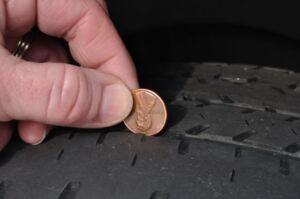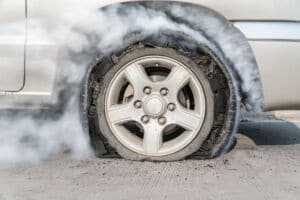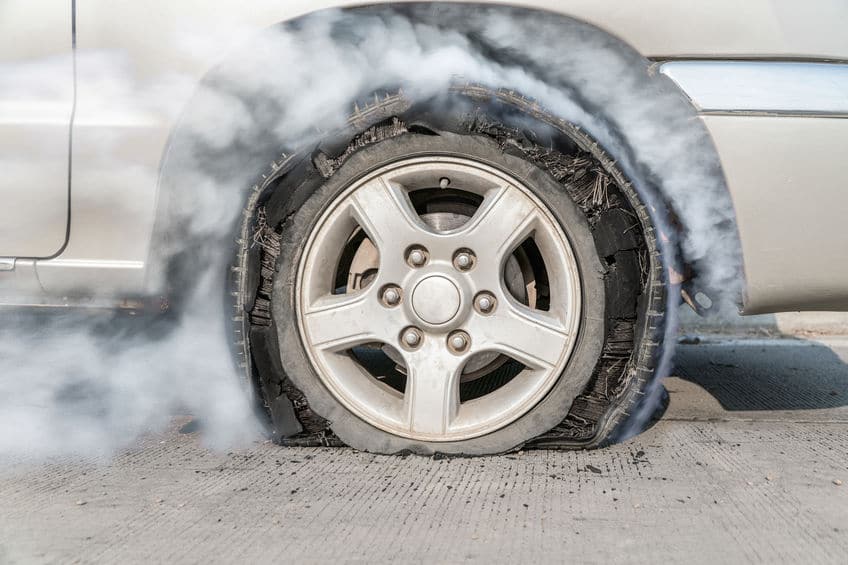A wise man once said to always invest in things that stand between you and the ground. Some examples include decent shoes, good mattresses, and, of course, good tires. Your tires are what protect you and your car from the roadways. They are the link between your life and the ground. It’s crucial to keep an eye on your tire’s health and have them replaced immediately if you notice they are damaged or the tread is worn out to avoid a tire blowout and a roadside emergency.
If you have been a driver in the Atlanta area you most likely have experienced a blown, flat, or damaged tire while traversing on our busy freeways and roads. With all of its industrialization, growth, and population, Atlanta is home to many potholes, metal shrapnel debris, nails, screws, and other sharp and pointy objects littered around our streets and highways. Driving is already a dangerous task in an urban squall, and having your tire blowout, shred, cut or damaged while making your commute can be a scary predicament.
When it comes to your car’s tires, it’s important to know how to properly inspect them so you can make sure you’re going in the right direction to avoid trouble in its tracks. In addition, when you are inspecting the health of your tires, it comes in handy knowing what exactly to look for to prevent a tire blowout.
What Causes a Tire Blowout?
There are a couple of different factors that can cause a tire blowout. Some include pre-existing damage such as abrasions or punctures in your tire. Underinflated or over-inflated tires can also lead to a tire blowout.
Warning Signs of a Tire Blowout
It comes in handy knowing exactly what to look for to prevent a tire blowout. Here are a few warning and troublesome signals that your tires are in bad shape which could possibly lead to a tire blowout:
- Wearing damaged tires
- Low tread. Read below how to check if you tire tread is low.
- Uneven tread wear. This could be caused by improper inflation, improperly aligned wheels, or problems due to suspension.
- Excessively worn tires
- Underinflated or over-inflated tires
- Excessive vibration. If your tires are vibrating, this may be a sign of your wheels being improperly aligned, unbalanced, or bent. This can also be a sign of internal tire damage. If your tires are vibrating, you should have them properly serviced as soon as possible.
- Weak spots on your tire. If there are blisters or areas of that bulge, it is time to replace your tire. Weak spots on your tire can lead to
How to Check Your Tire’s Tread with the Old Penny Trick
Follow the old penny trick to check your tire’s tread. How to do this: insert a penny into your tire. If you can see the TOP of Abe Lincoln’s head, your tire is too worn.

Dos and Don’ts to Avoid a Tire Blowout
We can’t anticipate an accident, but prevention and preparation are both keys when it comes to avoiding roadside emergencies. The best way to prevent a tire blowout is to make sure your tires are in good health.
Do check your tire pressure often. Keep a handy tire pressure gauge in your car and check your tire’s PSI often.
Do get good tires. Driving on quality tires is worth the investment. Your tires are what protect you and your car from the road.
Don’t drive on old tires. This can lead to a tire blowout and also destroy your rim.
If you are faced with a tire blowout, read our pro-tips below on how to survive a tire blowout.

How to Survive a Tire Blowout in 10 Steps
- Don’t turn the wheel.
- Remain calm and take a deep breath.
- Steer straight ahead with your hands on 10 and 2.
- DO NOT SLAM ON YOUR BRAKES.
- Keep your foot lightly on the gas pedal.
- Let your car slow down gradually by itself.
- Once you are under 25-30 MPH, slowly turn your wheel and lightly press the brake to stop.
- Pull over in a safe spot.
- Turn on your hazards.
- Call for help.
Step 1: DO NOTHING. Don’t turn the wheel and DON’T slam on the brakes. The best thing you can do when you are first faced with a tire blowout is nothing.
Step 2: Remain calm. Take a deep breath and remain calm. Try not to panic.
Step 3: Steer Straight. Grip your steering wheel and steer straight ahead with your hands on 10 and 2. Do your absolute best to keep your car steering straight. If you have a tire blowout, your car will feel like it’s pulling to one side, and it might even fishtail. It’s crucial to NOT jerk the wheel or turn it sharply because it can result in a much worse outcome.
Another instinct we have when a tire failure occurs while driving is to twist our steering wheel in hopes of correcting and directional changes that the car seems to be making after the blowout. Turning your steering wheel at high speeds can cause your vehicle to spin out and possibly collide into oncoming traffic. Hold the wheel straight with a sturdy grip and let the car come to a slow and safe speed before making any quick turns or cuts with the wheels.
Step 4: DO NOT SLAM ON YOUR BRAKES. This may be our first reaction, but it’s actually the worst thing to do during a tire blowout. Instead, allow your car to slow down by itself.
When you experience a tire blowout, your first instinct is to hit the brakes. But this can cause a very dangerous reaction from your car and can cause more harm than good. Experts say to let the car slow ON ITS OWN to under 25-30mph before hitting your brakes. In fact, giving a few, light pumps on the gas pedal will help stabilize the car and keep you headed forward. The blown or shredded tire will act as a brake on its own, by the dragging effect it takes on the road. This will help slow your car to a reasonably safe speed as you pull over or exit a highway.
Step 5: Keep your foot lightly on the gas. Accelerating just a little bit after a tire blowout will help you maintain momentum.
Step 6: Let your car slow down gradually while lightly pressing the gas.
Step 7: Once you are under 25 MPH, slowly turn your wheel and lightly press the brake to come to a stop.
Once you have regained control of your vehicle, let it ride until your speed has decreased to 30 miles per hour or lower. This speed is the top limit for safely applying the brakes and gently turning the wheel to exit to the emergency lane or off to the side of the road. The blown tire acts like a parachute and will drag your vehicle to a lower speed on its own without much time or resistance.
Step 8: Pull over in a safe area.
Step 9: Turn on your emergency hazard lights. It’s also a good idea to keep reflective cones or triangles in your car in case of a roadside emergency.
Step 10: Call for help. Once safely your vehicle is safely off the road or highway and at a full stop, take a deep breath. A blown or damaged tire while driving can be highly stressful and alarming. Make sure you are okay. Gather yourself and turn on your hazard lights. Once you have calmed down and regained focus, call for a professional towing service to come and assist you.
If you are around the metro Atlanta area, call Marietta Wrecker Service at (770) 422-6614 for reliable and quick 24/7 roadside assistance for tire blowouts and more.
Roadside Assistance in Metro Atlanta and Beyond
Our Emergency Roadside Assistance Service provides the following:
- Car Lockout Service
- Tire Change
- Dead Battery
- Jump Starts
If you need 24/7 emergency roadside service, Marietta Wrecker Service is available to to help. Contact us to help out with your emergency!
